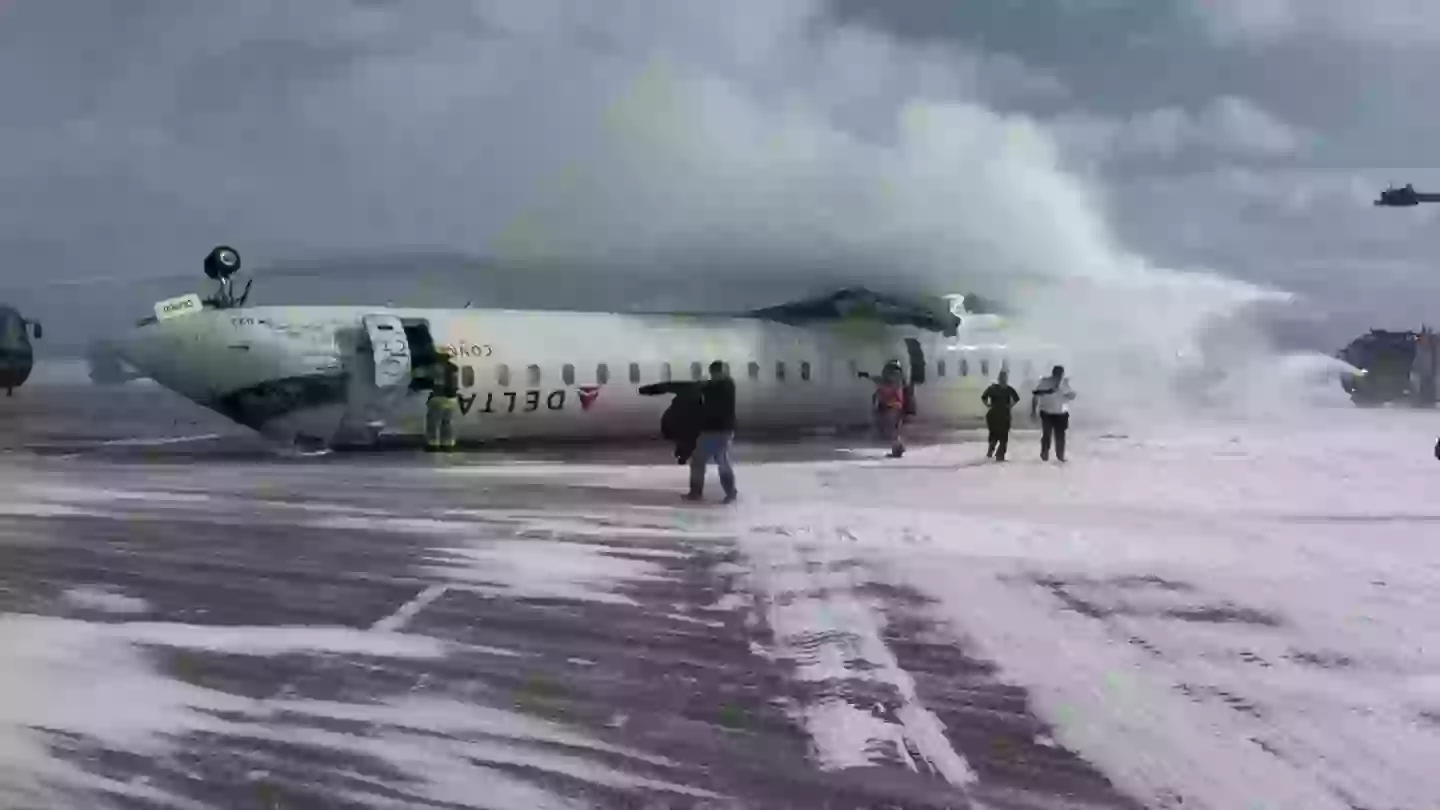The flight crash landed at Toronto Pearson International Airport yesterday
A survivor of the Delta Air Lines crash in Toronto shared a terrifying image taken just moments after the plane crash landed.
The Delta Flight 4819 had departed from the US city of Minneapolis and was bound for the Canadian city, where it crash landed on the runway. It has since been confirmed that all 76 passengers and 4 crew members were safely evacuated from the plane — 18 of whom were hospitalised for their injuries.
Delta has since issued an update on the incident on their website, confirming that all injured passengers have since been discharged from hospital.
“Toronto Pearson is aware of an incident upon landing involving a Delta Airlines plane arriving from Minneapolis. Emergency teams are responding. All passengers and crew are accounted for,” the airport said in a statement confirming the crash.
Footage showing the terrifying aftermath of the crash has since appeared across social media, with one passenger sharing a photo of herself inside the upside down cabin. Watch the clip below:
Taking to Snapchat, user Ashley Zook shared several videos from the aftermath, including one where she was strapped into her seat seemingly upside down.
“I was just in a plane crash. Oh my god,” she can be heard saying in the clip.
Passenger John Nelson also shared footage from the aftermath to his Facebook account, which showed passengers walking away from the plane as it was sprayed down with foam.
“Most people are going to be okay, we’re all getting off, there’s some smoke going on,” he can be heard saying in the video, adding in the caption that he was ‘ok’ after the incident.
It’s currently unclear what caused the flight to crash, however footage captured by surviving passengers shows the aircraft missing one of its wings.
“The hearts of the entire global Delta family are with those affected by today’s incident at Toronto-Pearson International Airport,” said Delta CEO Ed Bastian said in a statement.
“I want to express my thanks to the many Delta and Endeavor team members and the first responders on site. We are working to confirm the details and will share the most current information as soon as it becomes available. In the meantime, please take care and stay safe.”
“We are very grateful there was no loss of life and relatively minor injuries,” added Deborah Flint of the Greater Toronto Airports Authority (via BBC).
An investigation is currently underway, led by the Transportation Safety Board of Canada.
“The NTSB is leading a team of U.S. investigators to assist the Transportation Safety Board of Canada with their investigation of today’s accident of a Delta Air Lines Bombardier CRJ900 at Toronto Pearson International Airport,” the US Federal Aviation Administration added.
“Per international protocols under the International Civil Aviation Organisation’s Annex 13, any information about the investigation will be released by the Transportation Safety Board of Canada.”
The crash comes just a under a month after the deadliest US aviation crash since the September 2001 attacks, when a passenger jet collided mid-air with a military helicopter near Ronald Reagan Washington National Airport in Washington DC.
LADbible Group previously approached Delta Air Lines for comment.
Investigators have been trying to piece together what happened in the moments leading up to the aviation disaster which took place on 29 January.
Now, data from an air traffic control radar has revealed that the army helicopter carrying three soldiers was flying 100ft higher than it should have been.
Captain Rebecca M. Lobach, 28, was on the fateful flight alongside Staff Sgt. Ryan Austin O’Hara, 28, and Chief Warrant Officer 2 Andrew Loyd Eaves, 39.
The trio were out on a routine training exercise in Washington, D.C., and the maximum altitude for helicopters in the area they were flying in is 200ft.
The airspace surrounding the Ronald Reagan Washington National Airport is typically very busy and crossovers between planes and helicopters aren’t out of the ordinary.
However, data gathered from an air traffic control tower states that the chopper was flying at 300 feet, according to authorities.
The National Transport Safety Board (NTSB) explained that radar data is rounded to the nearest 100ft, meaning the chopper was flying somewhere between 251ft and 349ft in the air.
The American Airlines jet had been cleared to land at the nearby airport and was at around 325ft at the time of the collision.
It is hoped that more details about the circumstances surrounding the collision will emerge once the Black Hawk wreckage has been retrieved from the Potomac River.
All 67 victims have now been recovered from the water, officials announced on Tuesday (4 February), and all but one have been positively identified.
Emergency responders have spoken out about the huge mental toll retrieving the bodies has taken on them, with one firefighter saying that crews were ’emotionally wiped out’.
Authorities said the American Airlines pilots made a last ditch effort to stop the devastating crash, by trying to propel the plane carrying 64 people upwards.
Todd Inman of the NTSB previously explained: “At one point very close to the impact, there was a slight change in pitch, an increase in pitch.”
His colleague Brice Banning, who is in charge of the investigation, added: “The crew had a verbal reaction. Sounds of impact were audible about one second later, followed by the end of the recording.”
He explained that the probe into the incident has a lot of ‘complex’ circumstances, saying: “There are a lot of pieces here. Our team is working hard to gather this data.”


